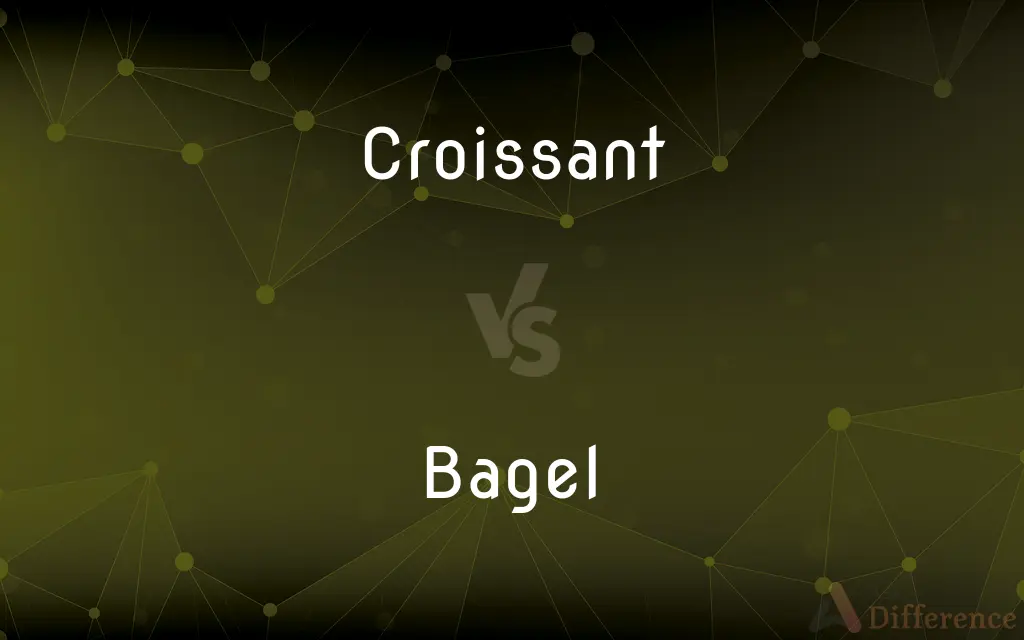Croissant vs. Bagel — What's the Difference?
Edited by Tayyaba Rehman — By Maham Liaqat — Updated on May 4, 2024
Croissants are buttery, flaky pastries known for their crescent shape, while bagels are dense, chewy breads typically boiled before baking.

Difference Between Croissant and Bagel
Table of Contents
ADVERTISEMENT
Key Differences
Croissants originate from France, characterized by their layered, buttery texture and flaky exterior achieved through a meticulous lamination process involving folding butter into dough multiple times. Conversely, bagels come from Jewish communities in Poland, known for their dense texture and chewiness, achieved by boiling the dough before baking it, which also gives the crust a distinctive shine.
While croissants are often enjoyed as a part of breakfast or as a snack, commonly paired with coffee or filled with chocolate, cheese, or ham, bagels are a versatile base for a variety of toppings, such as cream cheese, smoked salmon, or various spreads, and are a staple in both breakfast and lunch menus.
The baking process for croissants requires careful temperature control and timing to achieve the perfect rise and layered texture, highlighting the pastry's airy interior. On the other hand, bagels are first boiled in water, sometimes with honey or malt added, which sets the crust before it even enters the oven, resulting in a chewy texture with a glossy finish.
Nutritionally, croissants are higher in butter and therefore fat and calories, providing a rich and decadent taste. Bagels, while still calorically dense, offer a firmer texture and are often made with whole grains, providing more fiber and a lower fat content.
Croissants are often seen as a treat or luxury given their rich content and complex preparation, suitable for occasional indulgence. Bagels, meanwhile, are considered more of an everyday staple, robust and filling enough to serve as the foundation for a hearty meal.
ADVERTISEMENT
The cultural significance of each also varies; croissants are a symbol of French culinary art, often associated with sophistication and leisurely mornings, whereas bagels represent a cornerstone of Jewish culinary traditions, symbolizing community and continuity.
Comparison Chart
Origin
France
Jewish communities in Poland
Texture
Flaky, buttery, airy
Dense, chewy, glossy crust
Preparation
Laminated dough with butter, baked
Dough boiled then baked
Common Uses
Breakfast pastries, desserts
Sandwich base, breakfast staple
Nutritional Content
Higher in fat due to butter
Often made with whole grains, lower in fat
Cultural Significance
Symbol of French culinary luxury
Emblematic of Jewish community and heritage
Compare with Definitions
Croissant
A buttery, flaky, light pastry of French origin.
She enjoyed a warm croissant with her morning coffee.
Bagel
A dense, chewy bread with a hole in the center.
She topped her sesame bagel with cream cheese and lox.
Croissant
Made from laminated dough, creating thin, tender layers.
The bakery prides itself on the delicate layers in its homemade croissants.
Bagel
Often topped with seeds like sesame or poppy, or made with whole grains.
He always preferred whole wheat bagels for extra fiber.
Croissant
Often eaten plain or filled with chocolate, cheese, or meats.
He chose a ham and cheese croissant for a quick lunch.
Bagel
Integral to Jewish-American culinary traditions.
Bagels and lox are a staple at many Jewish holiday brunches.
Croissant
Associated with luxury and indulgence in cuisine.
Their weekend brunch always featured freshly baked croissants.
Bagel
Boiled before baking, which gives it a distinctive texture.
Bagels get their chewy texture from a quick boil in water.
Croissant
Typically shaped in a crescent, symbolizing its French roots.
The crescent shape of croissants is iconic at French bakeries.
Bagel
Commonly used as a sandwich bread because of its sturdy texture.
The bagel sandwich filled with turkey and Swiss was his favorite lunch choice.
Croissant
A croissant (UK: , US: , French: [kʁwasɑ̃] (listen)) is a buttery, flaky, viennoiserie pastry of Austrian origin, but mostly associated with France. Croissants are named for its historical crescent shape and, like other viennoiserie, are made of a layered yeast-leavened dough.
Bagel
A bagel (Yiddish: בײגל beygl; Polish: bajgiel), also historically spelled beigel, is a bread product originating in the Jewish communities of Poland. It is traditionally shaped by hand into the form of a ring from yeasted wheat dough, roughly hand-sized, that is first boiled for a short time in water and then baked.
Croissant
A French crescent-shaped roll made of sweet flaky yeast dough, eaten for breakfast.
Bagel
A glazed, ring-shaped roll with a tough, chewy texture, made from plain yeast dough that is dropped briefly into nearly boiling water and then baked.
Croissant
A rich, crescent-shaped roll of leavened dough or puff pastry.
Bagel
A toroidal bread roll that is boiled before it is baked.
Croissant
A flaky roll or pastry in a form of a crescent.
Bagel
A score of 6-0 in a set (after the shape of a bagel, which looks like a zero).
Croissant
Very rich flaky crescent-shaped roll
Bagel
An overly materialistic and selfish young Jewish man.
Bagel
(tennis) To achieve a score of 6–0 in a tennis set.
Bagel
(sports) To hold an opponent to a score of zero.
Bagel
A glazed leavened doughnut-shaped roll with a hard crust.
Bagel
(Yiddish) glazed yeast-raised doughnut-shaped roll with hard crust
Common Curiosities
What is the traditional method of shaping a bagel?
Traditional bagels are shaped by rolling dough into a rope and then forming a circle, sealing the ends by rolling them together.
What makes a croissant different from a regular pastry?
A croissant is made from laminated dough, creating a unique flaky and buttery texture.
Can croissants be considered a healthy breakfast option?
Due to their high butter content, croissants are more indulgent and may not be the best choice for a healthy diet if consumed frequently.
How long does it typically take to make a croissant?
Making croissants usually takes about 12 to 15 hours, including dough preparation, resting, and multiple rolling and folding steps.
Is there a nutritional benefit to choosing whole grain bagels?
Whole grain bagels provide more fiber, vitamins, and minerals than bagels made with refined flour, making them a healthier choice.
How has the popularity of bagels spread globally?
Bagels have become popular worldwide, adapted in various cuisines with local flavors and ingredients, making them a global favorite for their versatility and satisfying texture.
What is the significance of the hole in the center of a bagel?
The hole in the center of a bagel helps it cook more evenly and provides its distinctive shape.
How do the flavors of plain croissants and bagels differ?
Plain croissants have a buttery and slightly sweet flavor due to the laminated dough, while plain bagels are more bread-like with a yeasty flavor.
Can bagels be considered a vegan food?
Bagels can be vegan if made without animal-derived ingredients like eggs or dairy, though it's important to check individual recipes or product labels.
Why are bagels boiled before they are baked?
Boiling bagels before baking helps to set the crust, creating their characteristic chewy texture and glossy surface.
Are croissants suitable for sandwiches like bagels?
While less common than bagels, croissants can be used for sandwiches, particularly those that are savory, like ham and cheese.
Can croissants be made with fillings other than butter?
Yes, croissants can also be made using margarine or other fats, but traditional French croissants are typically made with high-quality butter.
What are some creative ways to serve croissants at a gathering?
Croissants can be served as part of a brunch spread, filled with various sweet or savory ingredients, or even used to make mini sandwich appetizers.
What types of meals are bagels a part of, aside from breakfast?
Bagels are versatile and can be enjoyed in various meals, including lunch sandwiches and as a base for pizza-like snacks.
Share Your Discovery

Previous Comparison
Dolostone vs. Dolomite
Next Comparison
Adverb vs. ProverbAuthor Spotlight
Written by
Maham LiaqatEdited by
Tayyaba RehmanTayyaba Rehman is a distinguished writer, currently serving as a primary contributor to askdifference.com. As a researcher in semantics and etymology, Tayyaba's passion for the complexity of languages and their distinctions has found a perfect home on the platform. Tayyaba delves into the intricacies of language, distinguishing between commonly confused words and phrases, thereby providing clarity for readers worldwide.
















































